class: center, middle, inverse, title-slide # Week 04: Civil Wars ## Violence against Civilians <html> <div style="float:left"> </div> <hr color='#EB811B' size=1px width=800px> </html> ### Danilo Freire ### 1st October 2019 --- <style> .remark-slide-number { position: inherit; } .remark-slide-number .progress-bar-container { position: absolute; bottom: 0; height: 6px; display: block; left: 0; right: 0; } .remark-slide-number .progress-bar { height: 100%; background-color: #EB811B; } .orange { color: #EB811B; } </style> # Last week we saw that... .font150[ * C&H propose a greed-based theory of civil wars * Grievance are constant, so civil wars need another triggering factor * Opportunity: rebel groups revolt when they're able to * Lootable resources, money from diasporas and hostile governments, and low costs of fighting (poverty) explain civil war onset ] --- # Last week we saw that... .font150[ * F&L argue that state capability is the most important civil war predictor * Also proxied by GDP, like C&H's opportunity variable * Ethnic and religious heterogeneity don't matter once you control for income * Factors that favour insurgency (mountainous terrain, oil, unstable regimes) increase the risk of civil wars ] --- # Last week we saw that... .font150[ * Wimmer et al (2009) write ethnicity does play a role in civil wars * Ethnicity is useful because politicians mobilise it * Secession, rebellion, or group infighting * Excluded population fight for the first two, included groups for the latter (sometimes for secession too) ] --- # Last week we saw that... .font150[ * Most variables don't have strong predictive power * GDP per capita and population are the best predictors of civil conflicts * Statistical significance is not the same as practical or predictive significance ] --- class: inverse, center, middle # Violence against Civilians <html><div style='float:left'></div><hr color='#EB811B' size=1px width=720px></html> --- # Kalyvas (1999) .center[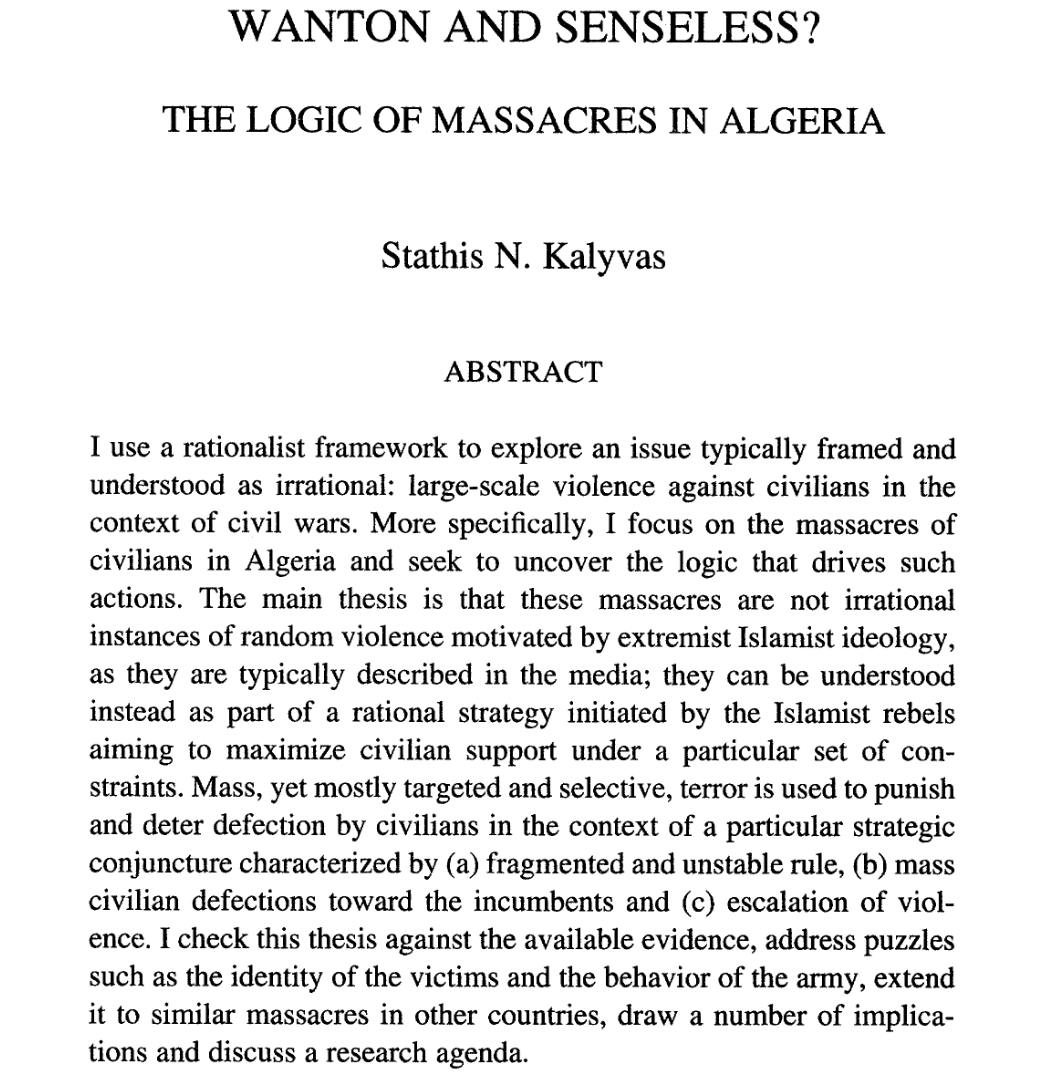] --- # Some context .font150[ * The Algerian Civil War lasted from 1991 to 2002 * Islamist groups vs the government * Onset: government cancelled 1991 elections after they thought the Islamic Salvation Front (FIS) would win * FIS was banned and members arrested, Islamist guerrillas rebelled against the government * Two main rebel groups: Islamic Armed Movement (MIA) and Armed Islamic Group (GIA) ] --- # Some context .font150[ * In 1994, talks between FIS and the government took place * GIA declared war against FIS * Pro-Army party won the next election (1997) * MIA surrended and GIA were hunted down * 1996-1999 peak violence; civil war ends in 2002 (government victory) ] --- # Some context .font150[ * *La sale guerre* * 44,000 to 100,000 deaths * Salafist Group for Preaching and Combat (GSPC), a GIA dissident group, later affiliated with Al-Qaeda and continue fighting in the Maghreb ] --- # Kalyvas (1999) .font150[ * Rational choice approach to mass violence * Massacres are not acts of barbarism, but a war strategy * Violence maximises civilian support under constrains * Illustrates his case using the Algerian Civil War as an example ] -- --- # Kalyvas (1999) .font150[ * **Questions**: - Should political organisations kill civilians randomly? - Specifically, why would *insurgents*, who tend to be weaker, kill civilians? ] -- .font150[ * *No*] -- .font150[ * *To find infiltrated enemies and prevent civilian defection* * Repression is effective: - Cheaper than selective benefits - Useful in areas and periods of contested rebel control ] --- # Targets .font150[ * Local opponents, mainly those associated with the government * Civilians associated with other insurgents * Defectors ] -- .font150[ * **Question**: how to identify the enemies? ] -- .font150[ * Access to reliable local information ] --- # A theory of selective violence .font150[ * Rebels and the government have fragmented sovereignty * But rebels and gov't forces often don't have full control oves the territory * They use coercion to elicit information from citizens and punish the enemies * Constraints faced by denouncers provide a good way to model the process * Key constraint is *the likelihood of retaliation* ] --- # A theory of selective violence .font150[ * In areas over which the rebels/gov't have full control, they can easily retaliate citizens * In contested areas, citizens can switch sides and it's hard for parties to use selective violence * Denunciation leading to selective violence is most likely where one actor exercises *dominant but incomplete control* * **Question**: in which type of conflict actors *might not* need to solicit information to citizens? ] -- .font150[ * Ethnic civil wars: private information is often available ] --- # Territorial control and violence .center[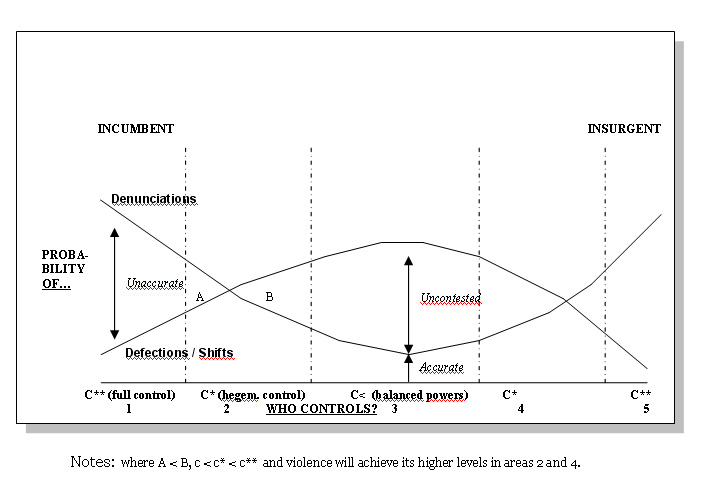] --- # Territorial control and violence .font150[ * Violence is more likely in zones 2 and 4 - Dominant but incomplete control by the rebels - The same for incumbents * As they lose control over the population, actors compensate by increasing the level of brutality * *This process can happen elsewhere*, not only in Algeria * The level of violence probably does *not* come from ideology, but from territorial control ] --- class: inverse, center, middle # Questions? <html><div style='float:left'></div><hr color='#EB811B' size=1px width=720px></html> --- # Humphreys & Weinstein (2006) .center[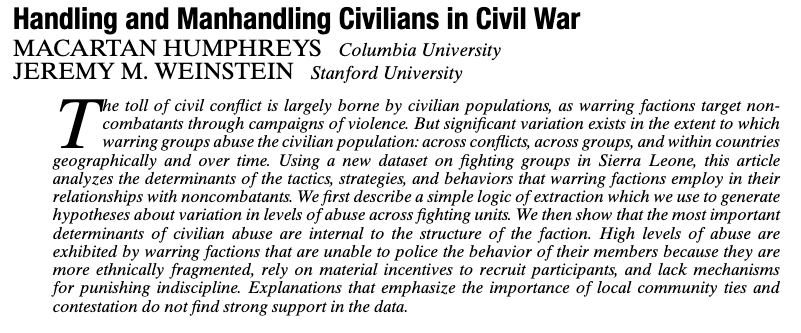] --- # Humphreys & Weinstein (2006) .font130[ * "...the extent of civilian suffering varies across conflicts, over time within a conflict, and across geographic regions in countries that experience violence" * Three factors: - Incentives for groups to be violent - Territorial control - *Poor internal cohesion* * "Units composed of members with private goals, which organize into ethnically heterogeneous groupings and lack internal mechanisms to discipline behavior, exhibit relationships with noncombatants characterized by coercion and abuse" ] --- # Humphreys & Weinstein (2006) .font150[ * Model: * Too much violence is counterproductive: "kills the goose that lays the golden egg" * Too *little* violence is also counterproductive: rebels will lose without information and conquest * There exist an optimal point where violence is effective: restrained violence + public goods production * *When do groups find that equilibrium?* ] --- # Hypotheses .font150[ * 8 hypotheses to explain variation in rebel violence ] -- .font150[ * H1: Abuse levels are likely to be higher in poorer areas - Rationale: Fewer resources to extract in the long run, less need for constrain] -- .font150[ * H2: Lower levels of abusiveness should be apparent in geographic zones in which warring factions are fighting in their home communities - Repeated interactions, social connections ] --- # Hypotheses .font140[ * H3: Lower levels of abusiveness should be apparent in geographic zones in which warring factions are predominantly of the same ethnic group as members of the local community - Same: repeated interactions, social connections ] -- .font140[ * H4: Greater levels of contestation will be associated with higher levels of abuse - More competition, more violence: monopolies are efficient] -- .font140[ * H5: Warring factions that recruit combatants using offers of private benefits are more likely to exhibit high levels of civilian abuse - Private incentives are not the same as public incentives: greed ] --- # Hypotheses .font150[ * H6: Warring factions with more dense social structures have lower levels of abuse * H7: More ethnically homogenous factions should exhibit lower levels of civilian abuse - Same: repeated interactions, social connections ] -- .font150[ * H8: Factions with tight disciplinary structures are likely to be less abusive of civilian populations - Control over rogue soldiers] --- # Conflict in Sierra Leone .font150[ * Civil war from 1991-2002 * Blood diamonds * Majority of crimes perpetrated by the Armed Forces Revolutionary Council (AFRC) and the Revolutionary United Front (RUF), supported by Charles Taylor (Liberia) * UN sent a mission in 1999; it failed * British Armed Forces intervened in 2000: conflict over by 2002 ] --- # Data .font150[ * Representative sample (1,043 combatants): avoids selection and partisan biases * Asked questions about characteristics of armed groups during all stages of the combat - Problem: selective memory * Units of analysis: - same faction and chiefdom (FCH) - subfaction and district (SFD) ] --- # Results .center[] --- # Results .center[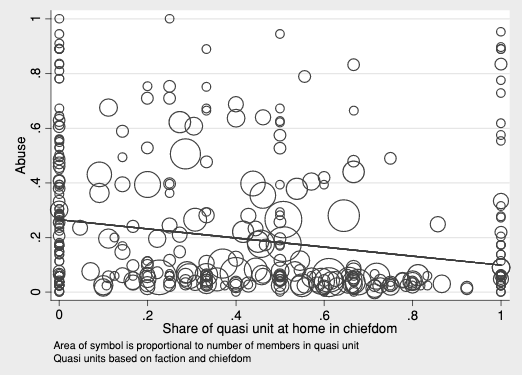] --- # Discussion .font150[ * Support for the hypothesis that material incentives increase violence against civilians * Strong support for the hypothesis that internal discipline decreases violence * Other variables have little or no effect ] --- # Discussion .font150[ * Violence is largely explained by characteristics of the fighting units themselves * Weak relationship between the extent of combatant–community ties and patterns of abuse * Wealth is also nor correlated with more violence - Little variation in wealth, diamond wealth not captured by indices? * No support for territorial control (Kalyvas) ] --- class: inverse, center, middle # Questions? <html><div style='float:left'></div><hr color='#EB811B' size=1px width=720px></html> --- # Balcells (2010) .center[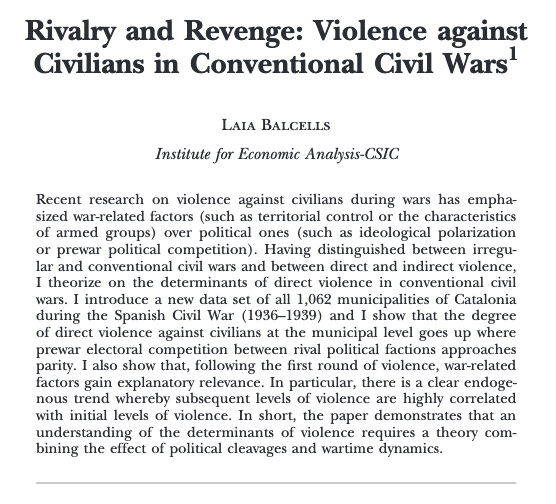] --- # Balcells (2010) .font150[ * Kalyvas and Humphreys and Weinstein de-emphasise political variables * Many civil wars are fought for political reasons: regime change, self-determination, etc * F&L equate all civil wars with guerrilla wars * B&K affirm that about 50% of civil wars are conventional wars, such as the Spanish Civil War ] --- # Balcells (2010) .font150[ * Conventional civil wars: strong control over populations * Irregular wars: contested areas * **Hypothesis**: While violence in irregular wars in connected with military competition to gain territory, in conventional civil wars violence is caused by *prewar political cleavages* ] --- # Spanish Civil War .center[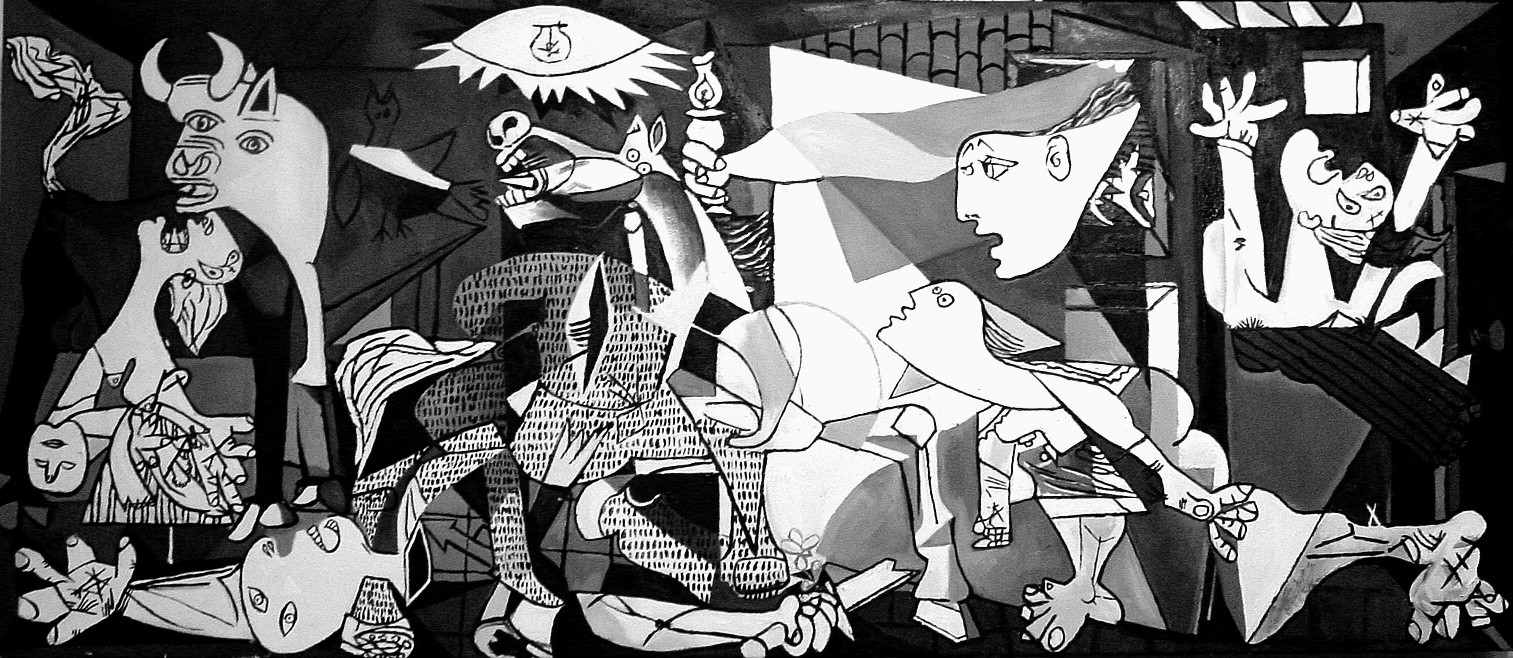] --- # Theory .font150[ * Killings occur in clearly delineated spaces * Civilians are generally isolated from the battlefield - Indirect violence (bombings) is cost-effective * In guerrilla wars, information about enemies is difficult - Selective violence * Why use selective violence in conventional civil wars? * Rebel groups target *highly mobilised supporters of the rival* ] --- # Hypotheses .font150[ * When is violence more likely? * **Rivalry**: * H1: The greater prewar competition approaches parity between groups, the higher the levels of violence perpetrated by the armed group controlling that locality (*rivalry*) - If the enemy has a large majority or a large minority, civilians restrain their armies - When groups have parity, strong supporter of each side push armies to fight ] --- # Hypotheses .font150[ * **Revenge**: * H2: The higher the levels of violence perpetrated by an armed group controlling a locality at t1, the higher the levels of violence perpetrated by the rival armed group in the same locality during the subsequent time period (*revenge*) - Tit-for-tat ] --- # Results .center[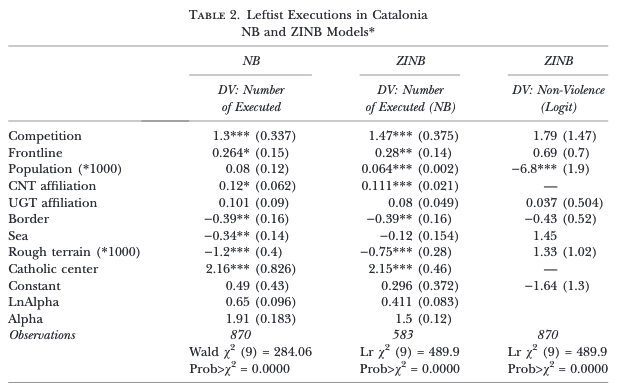] --- # Results .center[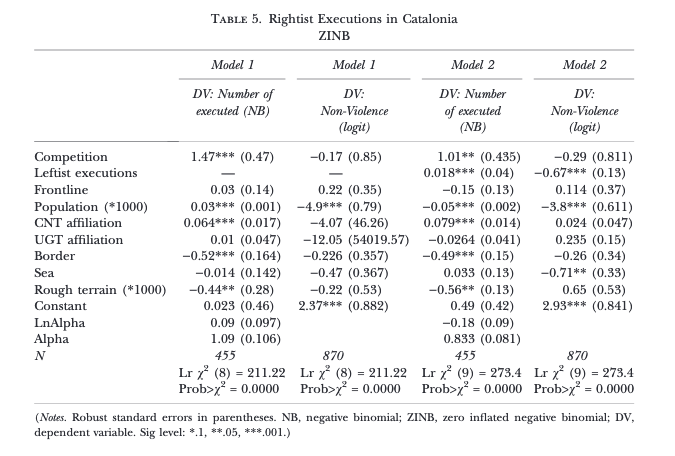] --- # Discussion .font150[ * In both cases, competition is positively associated with violence * Presence of CNT (labour union) and Church centres increase violence * Montainous terrain, proximity to France and to the sea decrease executions (exit) ] --- # Discussion .font150[ * In conventional wars, groups target civilians according to their public identities * In locatities with high parity in the prewar, violence is used to change the status quo * Local collaboration is not endonegous with territorial control, but to prewar mobilisation * Grievances can explain civil war violence ] --- class: inverse, center, middle # Questions? <html><div style='float:left'></div><hr color='#EB811B' size=1px width=720px></html> --- # Cohen (2013) .center[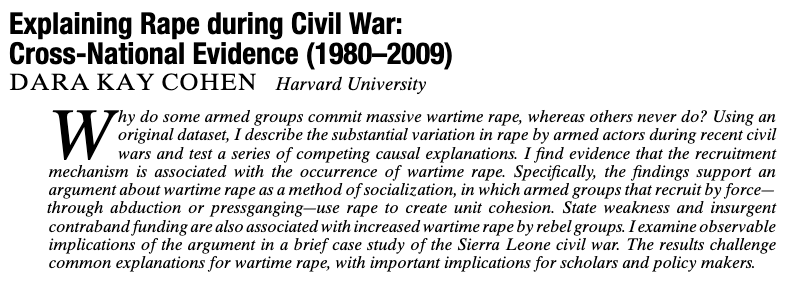] --- # Cohen (2013) .font150[ * What explains wartime rape? * Three explanations for wartime sexual violence: - Greed - Ethnic hatred - Gender inequality * It appears that those explanations are not true * New hypothesis: *combatant socialisation* ] --- # Rape and combatant socialisation .font150[ * Gang rape is much more common in wartime than in peacetime * *Rape as a socialisation device* * Many combatants are abducted, so they create bonds of esteem by violating women * Men are more likely to be killed during wartime, women and girls more likely to suffer nonlethal violence and to experience long-run consequences of war ] --- # Hypotheses .font150[ * **Opportunity/greed**: ] -- .font150[ * H1: State collapse is correlated with higher state-perpetrated and insurgent-perpetrated levels of wartime rape - Collapse of social norms ] -- .font150[ * H2: Rape by insurgents is more likely in conflicts whereinsurgent groups rely on material resources. - "Individual incentives" ] --- # Hypotheses .font150[ * **Ethnic hatred** ] -- .font150[ * H3: Ethnic wars are associated with conflict-wide rape - Humiliation ] -- .font150[ * H4: States or insurgents who perpetrate genocide are more likely to commit wartime rape than those who do not - Inflict bodily or mental harm to other group ] -- .font150[ * H5: Secessionist wars, especially those featuring ethnic cleansing, are associated with insurgent-perpetrated rape - Ethnic cleansing or forced expulsion ] --- # Hypotheses .font150[ * **Gender inequality** ] -- .font150[ * H6: Greater gender inequality is associated with conflict-wide rape - Acceptance of violence against women - Shames not only the victim, but male relatives ] --- # Rape as combatant socialisation tool .font150[ * Peacetime rape tends to be private; wartime rape is often public * "Rite of passage" * Creates and solidifies social status for men * Act of camaraderie: increases group cohesion * Gang rapists are less likely to have committed other crimes and are considered less pathological than private rapists ] --- # Rape as combatant socialisation tool .center[] .font150[ * H7: Insurgent groups that depend on abduction as a recruitment mechanism are more likely to perpetrate rape than groups that use other, more voluntary methods of recruitment * H8: States that depend on pressganging as a recruitment mechanism are more likely to perpetrate rape than groups that use other, more voluntary methods of recruitment ] --- # Results .center[] --- # Discussion .font140[ * Opportunity/greed mechanisms not supported for conflict-wide rape * But supported for rebel-group rape * Insurgent contraband funding is positively associated with rape * Ethnic hatred arguments are not supported for conflict-wide or rebel-group rape * Gender inequality also not supported (not shown) * Maybe GI was already so widespread that it doesn't explain sexual violence ] --- # Discussion .center[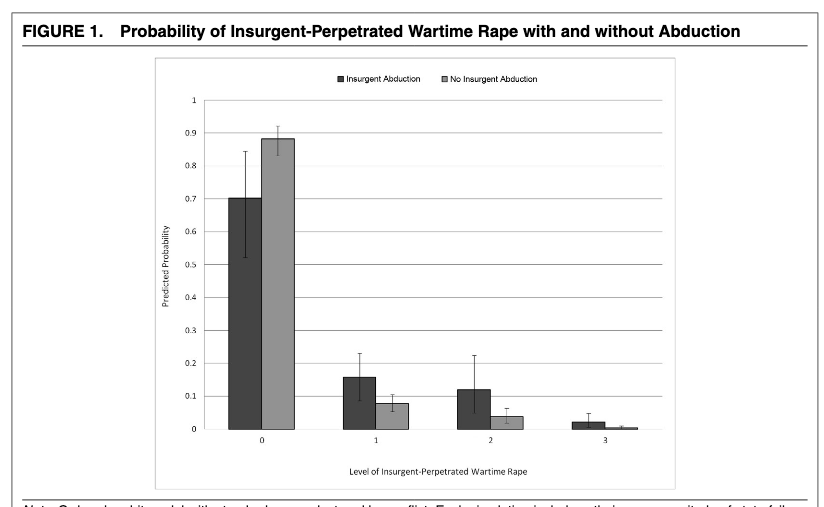] --- # Discussion .center[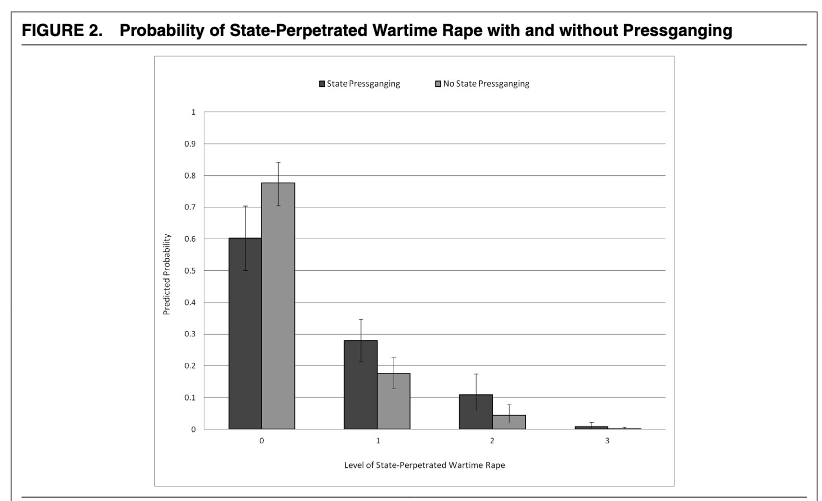] --- # Discussion .font150[ * Rape serves to socialise recruits, boost their morale, and increase group cohesion * Associated with state collapse * Lootable resources have a positive influence * Common suppositions were not supported ] --- class: inverse, center, middle # Questions? <html><div style='float:left'></div><hr color='#EB811B' size=1px width=720px></html> --- class: inverse, center, middle # See you next week! <html><div style='float:left'></div><hr color='#EB811B' size=1px width=720px></html>